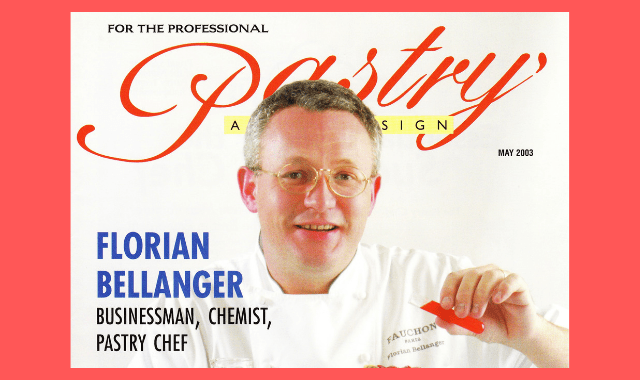By Sofia Perez
[Published by Pastry Art & Design, May 2003]
“Don’t go to New York with a big head, and don’t think they know nothing over there, because if you do, you will be surprised,” says Florian Bellanger, recalling the advice that Le Bernardin Executive Chef, Eric Ripert, gave him a few years ago in Paris. At the time, Bellanger worked at Fauchon’s legendary gourmet headquarters under Pierre Hermé. Ripert was looking for a new pastry chef, and Bellanger came highly recommended. Even today, Ripert’s advice continues to resonate with the 34-year-old Bellanger, who brings an open mind and a spirit of exploration to his current job, executive pastry chef of Fauchon’s operations in the United States.
“What I like about the U.S. is there is no taboo about food,” he says. Proving his point, he cites a recent trade show where he sampled French fries dipped in chocolate. “You may say it’s crazy but, believe it or not, it was good.” Currently, Bellanger is developing a marshmallow cake and also experimenting with peanuts, an ingredient he says his colleagues back in Paris would consider bizarre in a pastry recipe.
While Fauchon’s long and illustrious history is well known, Bellanger says that the company has always fostered creativity. Its gâteaux and macarons continue to turn heads and awaken taste buds, but his bosses allow him the room, and indeed encourage him, to try new things, while maintaining a foundation in classic French pâtisserie. Lately, he has been focused on breaking the mold of conventional cakes—literally. For Mother’s Day, he is producing a heart-shaped cake from a mold that has been custom-designed for Fauchon. Unlike the usual flat-topped variety, Bellanger’s version will have a rounded surface, like a three-dimensional heart, and will bear the imprint of a baby’s hand.
This spirit of innovation is also visible in Fauchon’s state-of-the-art pastry lab, located in Astoria, Queens—on New York’s Right Bank, if you will. It is there that Bellanger gets to play with all the latest high-tech toys, including a whipped-cream machine that uses ozone and produces 15%-20% more volume, which results in fillings that feel as light as air on the tongue.
Although his day-to-day work requires him to be part chemist, part businessman, and part engineer, he sees himself first and foremost as a pastry chef. Bellanger says he has trouble relating to those colleagues whose sole aim is to become famous. “I’m not against the idea of celebrity chefs,” he says. “But if you don’t keep your feet in the kitchen or the pastry lab, you’re dead. For people who have a big head, I have a mess-AHGE for them,” his melodic Parisian accent apparent. “We don’t save life. When you save life, you can have a big head. We are not surgeons.”
His grounded attitude does not diminish his enthusiasm for the field he has chosen, although his story makes you wonder if it wasn’t the other way around—that his career chose him. He grew up in Paris, the epicenter of pastry arts, though his family was not involved in the field. In fact, he says that his mother wasn’t a very ambitious cook or baker. Still, when she taught him how to make crêpes at the age of ten, he was hooked. And after only a few attempts, the student surpassed the teacher. “Your crêpes are so much better than mine,” his mother said to him in disbelief after he explained that he’d tinkered with the recipe, adding a little water to make the batter lighter. Clearly, he was a natural.
On Wednesdays, when he was off from school, his friends would ask him to hang out with them, but instead he invited them over to sample his pastry experiments. With the temerity of a 10-year-old, he moved directly from crêpes to a St.-Honoré cake. Despite fears that young Florian might set the house on fire while his parents were at work (which led the family to switch from a gas stove to an electric model), his mother encouraged his burgeoning obsession. “She’d bring me pastry books from the supermarket, the kind written for housewives,” he says. “And she knew that on Tuesdays, she had to stock the kitchen with eggs, milk, and flour.”
While Bellanger’s family was supportive, not everyone was so encouraging. When he was 15, he applied to work for a local baker but was turned down unceremoniously because “apprentices make too many mistakes.” It’s a memory that has stayed with Bellanger his whole life, one that rankles him even today. “You want to shake the guy and say, ‘Eh, how did you learn?’ You cannot be like that. We are craftsmen, and craftsmen are supposed to transmit what they know from one generation to the next. I don’t think you have to spend your whole life teaching, but you do have to spend a part of it sharing your experience with others.”
At Fauchon, Bellanger oversees a sizable staff of chefs and apprentices, giving him many chances to teach and to continue learning himself. He speaks fondly of his time at Le Bernardin, and says that he continues to use the knowledge he gained there every day. His current job presents a new set of challenges and opportunities. In his view, a restaurant and a pastry shop are two different worlds. In a restaurant, you can experiment with different temperatures and fragile presentations, while in a store you have to contend with issues of conservation relating to appearance, taste, and transportation. “It’s not only doing a beautiful cake but it’s having it delivered without damage. It gets more technical than doing desserts for a restaurant,” he says.
Despite the differences, he acknowledges that there is at least one common denominator for all pastry chefs—the need to be at your best every single day. “It’s not like doing a piece of sculpture that you work with for six months, and everybody’s going to look at it for the next 30 years. We’re constantly making new product, and it has to be consistently high-quality.” In other words, you’re only as good as your last batch of eclairs. But rather than viewing this as a source of pressure, Bellanger seems to thrive on the challenge.
For inspiration, he draws upon Fauchon’s vast product line, as well his own travels to places like Peru, Qatar, and Brazil, experimenting with spices and other ingredients in non-traditional ways. His newest idea includes the use of flowers as flavorings, such as ice cream made with violets and roses.
As he talks about his grand plans for the future, it doesn’t take long to see that his enthusiasm is genuine and infectious. Perhaps it’s because the ten-year-old Florian is still alive and well behind his wire-rimmed glasses and adult exterior. As you watch his eyes light up and listen to a torrent of French-inflected words encouraging you to taste one of his favorite pastries (such as the Breteuil, an almond and pistachio cookie with pistachio mousse and a chocolate praline center), you might need to pause for a second to check your surroundings. You’d be forgiven for momentarily thinking that it’s Wednesday afternoon in the Paris home of Bellanger’s childhood, and that you are one of the pals he’s invited over to sample his latest creation. Clearly, there has never been anywhere else he’d rather be than in the kitchen, engrossed in the process of making—and sharing—something sweet.



